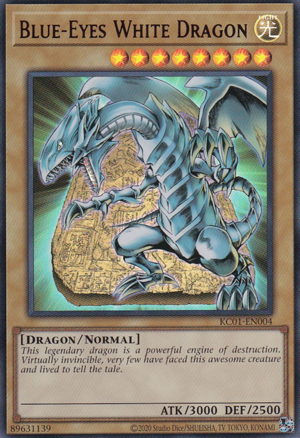Difference between revisions of "Attack Position"
MasterMarik (talk | contribs) (While not printed yet, it's already in the TCG Konami database so it's moot to mention it as a card to use this anymore.) |
Dinoguy1000 (talk | contribs) ({{Show card image}}; hatnote; {{In other languages}}; a bit more cleanup (though this still needs more)) |
||
| Line 1: | Line 1: | ||
| − | {{ | + | {{Redirect|Attack Mode|the Skill|""Attack Mode"" (Skill)}} |
| − | + | {{Show card image|Blue-Eyes White Dragon|A card in Attack Position}} | |
| − | + | '''Attack Position''', called '''Attack Display''' ({{Ruby|攻|こう}}{{Ruby|撃|げき}}{{Ruby|表|ひょう}}{{Ruby|示|じ}}, ''Kōgeki Hyōji'') in Japanese and '''Attack Mode''' in the English anime dub, is a [[battle position]] in which a [[Monster Card]] is [[face-up]] in a vertical position. In this position, the [[ATK]] value is used to represent this card, except where a card [[effect]] requires a specific examination of the [[DEF]] value. | |
| − | |||
| − | }} | ||
| − | {{ | ||
| − | |||
| − | |||
| − | |||
| − | |||
| − | |||
| − | |||
| − | |||
| − | |||
| − | |||
| − | |||
| − | |||
| − | |||
| − | |||
| − | |||
| − | |||
| − | |||
| − | [[ | + | Attack Position monsters should always be [[face-up]]. |
| − | + | == In other languages == | |
| − | + | {{In other languages | |
| − | + | | fr_name = Position d’Attaque | |
| + | | de_name = Angriffsposition | ||
| + | | it_name = Posizione di Attacco | ||
| + | | pt_name = Posição de Ataque | ||
| + | | es_name = Posición de Ataque | ||
| + | | ja_name = {{Ruby|攻|こう}}{{Ruby|撃|げき}}{{Ruby|表|ひょう}}{{Ruby|示|じ}} | ||
| + | | ja_romaji = Kōgeki Hyōji | ||
| + | | ja_trans = Attack Display | ||
| + | | ko_name = 공격 표시 | ||
| + | | ko_rr = Gonggyeok Pyosi | ||
| + | | zh_name = 攻擊表示 | ||
| + | | zh_pinyin = Gōngjí Biǎoshì | ||
| + | }} | ||
{{Gameplay}} | {{Gameplay}} | ||
[[Category:Gameplay]] | [[Category:Gameplay]] | ||
Latest revision as of 02:11, 15 March 2024

A card in Attack Position ("Blue-Eyes White Dragon")
Attack Position, called Attack Display (
Attack Position monsters should always be face-up.
In other languages[edit]
| Language | Name | Romanized | Translated |
|---|---|---|---|
| French | Position d’Attaque | ||
| German | Angriffsposition | ||
| Italian | Posizione di Attacco | ||
| Portuguese | Posição de Ataque | ||
| Spanish | Posición de Ataque | ||
| Japanese | Kōgeki Hyōji | Attack Display | |
| こうげきひょうじ (kana) | |||
| 攻撃表示 (base) | |||
| Korean | 공격 표시 | Gonggyeok Pyosi | |
| Chinese (Traditional and Simplified) | 攻擊表示 | Gōngjí Biǎoshì |